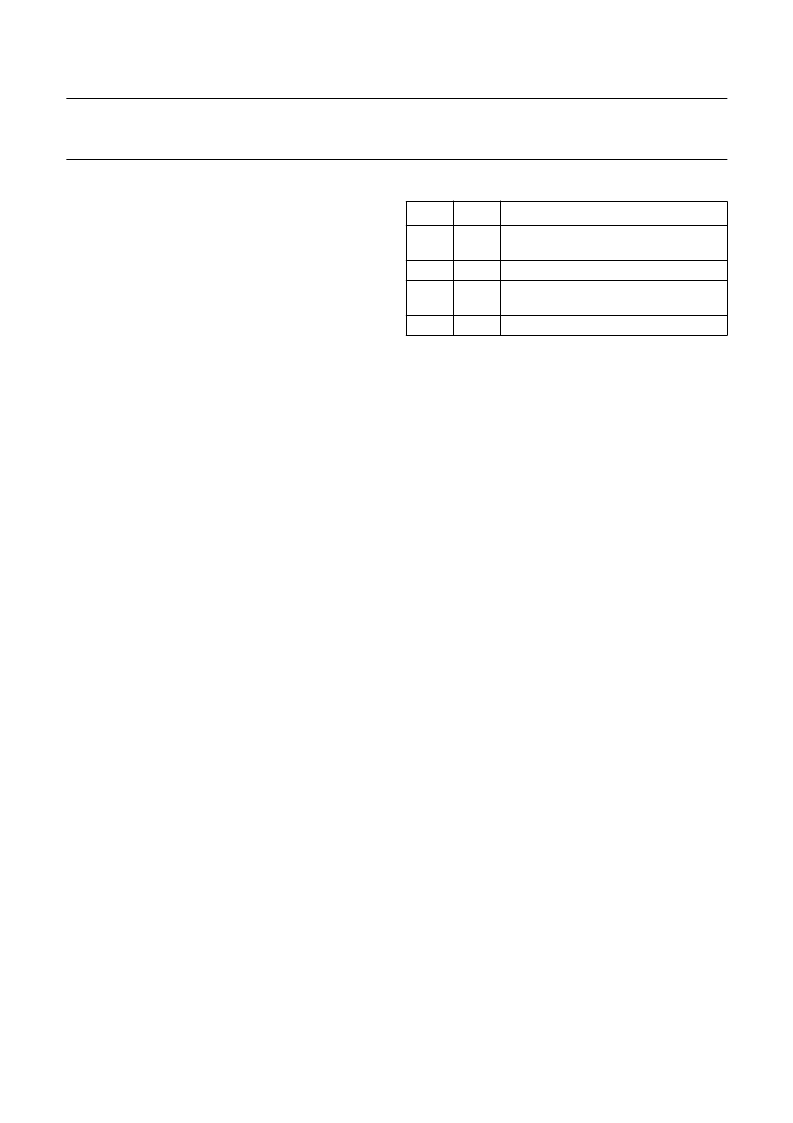- 您現(xiàn)在的位置:買賣IC網(wǎng) > PDF目錄382721 > UDA1345 (NXP Semiconductors N.V.) Economy audio CODEC PDF資料下載
參數(shù)資料
| 型號: | UDA1345 |
| 廠商: | NXP Semiconductors N.V. |
| 元件分類: | Codec |
| 英文描述: | Economy audio CODEC |
| 中文描述: | 經(jīng)濟(jì)音頻CODEC |
| 文件頁數(shù): | 12/28頁 |
| 文件大小: | 126K |
| 代理商: | UDA1345 |
第1頁第2頁第3頁第4頁第5頁第6頁第7頁第8頁第9頁第10頁第11頁當(dāng)前第12頁第13頁第14頁第15頁第16頁第17頁第18頁第19頁第20頁第21頁第22頁第23頁第24頁第25頁第26頁第27頁第28頁

2000 Apr 18
12
Philips Semiconductors
Preliminary specification
Economy audio CODEC
UDA1345TS
L3 interface
The UDA1345TS has a microcontroller input mode. In the
microcontroller mode, all of the digital sound processing
features and the system controlling features can be
controlled by the microcontroller. The controllable features
are:
System clock frequency
Data input format
Power control
DC filtering
De-emphasis
Volume
Mute.
The exchange of data and control information between the
microcontroller and the UDA1345TS is accomplished
through a serial hardware interface comprising the
following pins:
L3DATA: microcontroller interface data line
L3MODE: microcontroller interface mode line
L3CLOCK: microcontroller interface clock line.
InformationtransferviathemicrocontrollerbusisLSBfirst,
and is organized in accordance with the so called ‘L3’
format, in which two different modes of operation can be
distinguished; address mode and data transfer mode
(see Figs 4 and 5).
The address mode is required to select a device
communicating via the L3-bus and to define the
destination register set for the data transfer mode. Data
transfer for the UDA1345TS can only be in one direction:
for the UDA1345TS, data can only be written to the device.
Important
: since the UDA1345TS does not have a
Power-up reset circuit, after power up the L3 interface
registers MUST be initialized.
A
DDRESS MODE
The address mode is used to select a device for
subsequent data transfer and to define the destination
register set (DATA or STATUS). The address mode is
characterized by L3MODE being LOW and a burst of
8 pulses on L3CLOCK, accompanied by 8 data bits.
The fundamental timing is shown in Fig.4. Data
bits 0 and 1 indicate the type of subsequent data transfer
as given in Table 12.
Table 12
Selection of data transfer
Data bits 7 to 2 represent a 6-bit device address, with bit 7
being the MSB and bit 2 the LSB. The address of the
UDA1345TS is 000101 (bit 7 to bit 2). In the event that the
UDA1345TS receives a different address, it will deselect
its microcontroller interface logic.
D
ATA TRANSFER MODE
The selection preformed in the address mode remains
active during subsequent data transfers, until the
UDA1345TS receives a new address command.
The fundamental timing of data transfers is essentially the
same as in the address mode, shown in Fig.4. The
maximum input clock and data rate is 128f
s
. All transfers
are byte wise, i.e. they are based on groups of 8 bits. Data
will be stored in the UDA1345TS after the eighth bit of a
byte has been received. A multibyte transfer is illustrated
in Fig.6.
Programming the sound processing and other features
The feature values are stored in independent registers.
Thefirstselectionoftheregistersisachievedbythechoice
of data type that is transferred, being DATA or STATUS.
This is performed in the address mode, bit 1 and bit 0
(see Table 12). The second selection is performed by the
2 MSBs of the data byte (bit 7 and bit 6). The other bits in
the data byte (bit 5 to bit 0) are the values that are placed
in the selected registers.
When the data transfer of type DATA is selected, the
features Volume, De-emphasis, Mute and Power control
can be controlled. When the data transfer of type STATUS
is selected, the features system clock frequency, data
input format and DC filter can be controlled.
BIT 1
BIT 0
TRANSFER
0
0
DATA (volume, de-emphasis, mute,
and power control)
not used
STATUS (system clock frequency, data
input format and DC filter)
not used
0
1
1
0
1
1
相關(guān)PDF資料 |
PDF描述 |
|---|---|
| UDA1350AH | IEC 958 audio DAC(IEC 958音頻轉(zhuǎn)換器) |
| UDA1350ATS | IEC 958 audio DAC |
| UDA1351 | 96 kHz IEC 958 audio DAC |
| UDA1351H | 96 kHz IEC 958 audio DAC |
| UDA1351TS | 96 kHz IEC 958 audio DAC |
相關(guān)代理商/技術(shù)參數(shù) |
參數(shù)描述 |
|---|---|
| UDA1345TS | 制造商:PHILIPS 制造商全稱:NXP Semiconductors 功能描述:Economy audio CODEC |
| UDA1345TS/N2 | 制造商:NXP Semiconductors 功能描述:IC CODEC AUDIO 28-SSOP 制造商:NXP Semiconductors 功能描述:IC, CODEC, AUDIO, 28-SSOP |
| UDA1345TS/N2,112 | 功能描述:接口—CODEC AUDIO CODEC RoHS:否 制造商:Texas Instruments 類型: 分辨率: 轉(zhuǎn)換速率:48 kSPs 接口類型:I2C ADC 數(shù)量:2 DAC 數(shù)量:4 工作電源電壓:1.8 V, 2.1 V, 2.3 V to 5.5 V 最大工作溫度:+ 85 C 安裝風(fēng)格:SMD/SMT 封裝 / 箱體:DSBGA-81 封裝:Reel |
| UDA1345TS/N2,118 | 功能描述:接口—CODEC ECONOMY CODEC RoHS:否 制造商:Texas Instruments 類型: 分辨率: 轉(zhuǎn)換速率:48 kSPs 接口類型:I2C ADC 數(shù)量:2 DAC 數(shù)量:4 工作電源電壓:1.8 V, 2.1 V, 2.3 V to 5.5 V 最大工作溫度:+ 85 C 安裝風(fēng)格:SMD/SMT 封裝 / 箱體:DSBGA-81 封裝:Reel |
| UDA1345TS/N2118 | 制造商:Rochester Electronics LLC 功能描述: 制造商:NXP 功能描述: 制造商:NXP Semiconductors 功能描述: |
發(fā)布緊急采購,3分鐘左右您將得到回復(fù)。